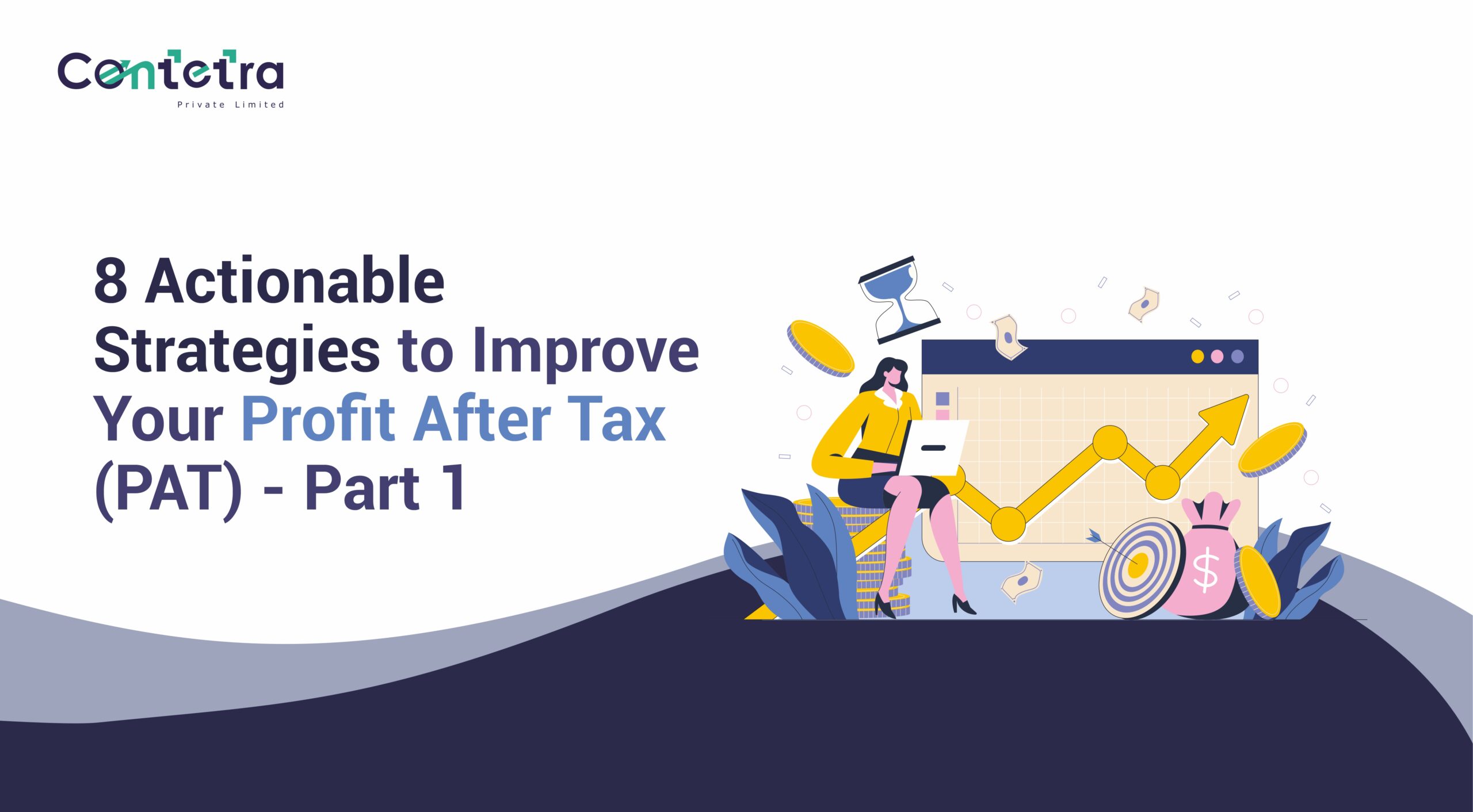In today’s fast-evolving business landscape, success is no longer just about growing your revenue. Real business strength lies in how much of that revenue you keep after all the costs, taxes, and inefficiencies are accounted for. That’s your Profit After Tax (PAT) a true measure of how lean, smart, and sustainable your business really is.
At Contetra, we’ve worked with dozens of businesses startups, family-run companies, and funded growth-stage firms. And we’ve seen one pattern repeatedly: Businesses that focus early on strategic profitability, not just top-line growth, build resilience and attract investor confidence.
This blog is Part 1 of a two-part series where we outline eight field-tested strategies used by high-performing finance teams to increase PAT. These aren’t complex theories they’re actionable ideas that you can start implementing this quarter.
Let’s dive into the first four.
1. Move from Cost-Based to Value-Based Pricing
Traditional pricing methods rely on this formula: cost + margin = price. While it covers your expenses, it ignores your customer’s perception of value. This is where value-based pricing stands out.
Value-based pricing aligns your prices with the perceived value of your product or service, not just the cost of production. This allows you to charge higher where the customer sees real benefits speed, service, branding, reliability, or outcomes.
Take inspiration from brands like Apple or Zomato Gold. Customers don’t pay only for the product; they pay for experience, time saved, and status. That’s value-based pricing in action.
What You Can Do:
- Identify the top three benefits your best customers care about.
- Conduct competitor research to benchmark prices.
- Interview sales teams to understand what customers actually value.
- Package offerings in a way that highlights outcome, not effort.
Over time, this shift can increase both pricing power and customer lifetime value. An ERP functional consultant can help structure your costing and pricing models within your ERP system to reflect real-time insights that support value-based pricing decisions.
2. Build a Sales Funnel That Converts
Many companies complain about lead quality or low conversion rates. But often the real issue is the lack of a structured sales funnel.
A well-structured sales funnel gives your team a roadmap to move leads from awareness to decision, with clear checkpoints and triggers at every stage.
Structure it in three simple stages:
- Awareness: Get in front of your audience with social media reels, Google ads, and customer referrals.
- Consideration: Educate them. Use webinars, case studies, free resources, or toolkits that show your credibility.
- Decision: Close with high-conversion landing pages, proof of ROI, clear CTAs, and real testimonials.
Sales funnels also let you forecast revenue more reliably and reduce your customer acquisition cost (CAC). A skilled ERP selection consultant can help align your ERP and CRM systems to track conversions, manage leads, and forecast revenue in real-time.
Quick Tip: Use a simple CRM like Zoho, Pipedrive, or even Google Sheets to track leads, automate reminders, and monitor conversion metrics.
Even a 10% increase in funnel conversion can improve your PAT significantly by making your marketing spend more efficient.
3. Keep More of What You Earn Through Smart Tax Planning
Your business might be profitable on paper, but how much of that reaches the bank depends on tax planning.
Effective tax optimization doesn’t mean bending rules. It means using incentives, schemes, and timing to your advantage.
One powerful example is presumptive taxation. If your business turnover is under ₹3 crores (and 95% of receipts are non-cash), you can opt to declare 6-8% of your receipts as income simplifying compliance and reducing the overall tax burden.
Other tax-saving levers include:
- Strategic depreciation of assets
- Investment-linked deductions under sections like 35AD
- Timely expense booking and provisioning
- TDS and advance tax management
What You Can Do:
- Get a mid-year tax health check done by a CA.
- Avoid last-minute tax planning in March it’s usually too late.
- Track recurring expenses to make sure they’re recorded correctly.
Every ₹1 saved on tax goes directly to PAT. And that’s real profitability.
4. Fix Your Accounting Foundation
What gets measured gets managed. If your accounting is inconsistent, delayed, or just plain wrong you’re flying blind.
Accounting isn’t just a compliance tool. It’s a strategic system to measure your financial health, uncover inefficiencies, and plan for the future.
To fix your foundation, start with these three essentials:
- Accrual-based accounting: Recognize revenue when earned, not when received. This gives a truer picture of performance.
- Expense matching: Align your costs with the revenues they helped generate.
- Depreciation and amortization: Reflect the wear and tear of assets accurately. This also reduces taxable income in a legitimate way.
We’ve worked with companies that had excellent products but poor accounting. Once we cleaned up their books and structured their MIS, they realized they were leaking margin through untracked expenses, delayed collections, and hidden liabilities.
An ERP functional consultant can also help identify whether your current ERP system is equipped to support automated financial reporting, compliance, and data visibility.
Pro Tip: Switch from Tally to cloud-based systems like Zoho Books or QuickBooks if you need better visibility and automation.
What’s Next?
You’ve now seen how pricing, sales funnels, tax strategy, and accounting are not isolated functions they are levers that directly impact your Profit After Tax.
In Part 2, we’ll cover four more strategies:
- How ERP systems and tech reduce inefficiencies
- Why inventory should work like cash, not stock
- Cutting costs without hurting customer experience
- And how consistency, not intensity, wins in the long run
Engaging an ERP functional consultant during this transformation ensures you not only implement the right tools but also optimize them to drive maximum profitability.
Implement even two of these eight strategies, and you’ll start seeing measurable impact on your margins.
Final Thoughts
Profit After Tax is the true heartbeat of your business. It tells you if your growth is real, scalable, and worth the effort.
It’s time to stop focusing only on revenue and start getting strategic about what you keep. That’s what separates thriving businesses from those that barely survive.
If you’re ready to build a PAT-focused strategy into your business, Contetra’s team of experts from finance professionals to experienced ERP selection consultants is here to help.
Stay tuned for Part 2.














